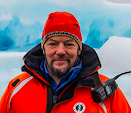The Hands’ Measure: Essays Honouring Leah Aksaajuq Otak’s Contribution to Arctic Science.
Edited by John MacDonald and Nancy Wachowich
Iqaluit: Nunavut Arctic College Media, 2018. 391 pages.
Reviewed by Kenn Harper
The Hands’ Measure, as its subtitle makes clear, is a book honouring the contributions of the late Leah Aksaajuq Otak of Igloolik, Nunavut. It is not a biography of Leah, but rather a collection of essays by Northern scholars – or scholars interested in the North – who have been inspired by Leah, her work, and her enthusiasm.
A few of the essays – those by John MacDonald (Stories and Representations: Two Centuries of Narrating Amitturmiut History; Leah Aksaajuq Otak: A Life in Language; and Reflections on a Flag), Sylvie LeBlanc (Our Old Sod House), Nancy Wachowich (Leah Aksaajuq Otak: The Measure of a Stitch and the Art of Translation), Noah Richler (Sunrise, Stories, and Snowhouses: A Conversation with Leah Otak), and J.C.H. King (Inuit Lives and Arctic Legacies: Leah Otak, Edward Parry, and Igloolik)– talk the most about Leah as a person, her interests, and her life history, including her education and her work. These are the most personal contributions.
Two others by Inuit contributors – Eva Aariak (A Stitch in Time: Inuktut, Sewing, and Self-Discovery), and George Qulaut (Capturing Souls: Beginnings of Oral History Work in Igloolik) – address two of the subjects most dear to Leah – language and its proper usage (in Eva’s essay) and oral history (in George’s chapter).
Two contributions treat the Igloolik Oral History Project as a resource and discuss its practical applications (Jack Hicks – “Once in a While”: The Igloolik Oral History Project as a Resource with Which to Understand Suicidal Behaviour in Historic Inuit Society; and Sheena Kennedy Dalseg – Reclaiming the Past and Reimagining the Future: The Igloolik Oral History Project, Education, and Community Development).
Still others relate less, or not at all, to Leah directly, but are Igloolik-centric in their research and discussions. These are the contributions by Claudio Aporta (Living, Travelling, Sharing: How the Land Permeates the Town through Stories), Willem Rasing (Encounters: Reflections on Anthropology and Cultural Brokers), and Susan Rowley (Ujakkat: Iglulingmiut Geology).
Some contributions are general in their scope, but are inspired by Leah’s work and enthusiasm. These are chapters by Hugh Brody (The People’s Land: The Film), Louis-Jacques Dorais (A Marriage in Nunavik), Bernadette Driscoll Engelstad (Restoring an Ancestral Legacy: Museum Collections, Inuit Clothing, and Communities), and Birgit Pauksztat (“Tass’ Nuann’!”: Tradition, Sports, and Friendship at the Kayak Club Nuuk).
Leah Otak believed that the emphasis of the Igloolik Oral History Project, in which she was a participant for many years, should be on the proper use of language. In the words of John MacDonald, “the information gathered in the interview was, to some extent, secondary to the quality and sophistication of the language used to convey the information.” Leah herself said, “Preserving oral histories is so important for future generations, because our language is changing fast. It’s beginning to be like English [in] structure…. But if people get interested, they can use the oral histories to learn – not just words but how [elders] would express themselves.”
Leah had a passion for word collecting. Like a true lexicographer, she obsessively wrote down new words she encountered wherever she was, and entered them in a vocabulary list she compiled once she was back home.
She was critical of the government’s approach to teaching Inuktitut. “In teacher training, no one monitors how Inuktitut is taught. No one is monitoring how well the teachers are speaking. The government solution comforts themselves – but it’s not Inuktitut…. Kids love to learn their language … but we’re not providing them with good quality education.”
Leah constantly showed empathy for the elders of Nunavut’s communities. Speaking of the old days of camp life, she juxtaposed it with the supposedly easier life in northern settlements today, a life, ironically, in which elders watch the rapid erosion of their culture and language and love grandchildren with whom they increasingly do not share a language. Leah claimed that “for the elders it wasn’t a struggle at all, not like they are struggling today.”
Nancy Wachowich describes Leah as a translator, but a translator not only of words, but also of concepts, of ways of seeing the world; in that sense she was a bridge between cultures. “She found ways to translate Inuit and Western knowledge traditions, working across both sides of the cultural divide.” Through her work at the science research centre in Igloolik, she brought southern researchers together with the community and its elders. Wachowich refers to Leah’s work as “cultural documentation and cultural translation.”
Nunavut Arctic College Media has done an admirable job in putting together a quality trade paperback book. It’s a big book, 391 pages, well bound. My only criticism is that it would have benefited by the inclusion of a map.
In the interest of full disclosure, I must state that I contributed one chapter to the volume (Inuit Oral History: Statements and Testimony in Criminal Investigations – The Case of the Killing of Robert Janes).



No comments:
Post a Comment